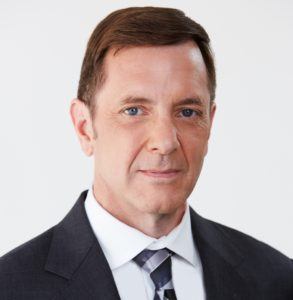“He’s a writer AND an actuary.”
The short description heading his LinkedIn profile remains true, but James Lynch will be stepping down from actively writing or providing actuarial services on behalf of the Insurance Information Institute at the end of May.
On Tuesday, Triple-I announced that Lynch will retire from his role as chief actuary next month.
Lynch, who came to Triple-I in 2014 with a unique resume that included a seven-year stint at the Miami Herald and more than 25 years in actuarial roles, has watched the insurance industry, the actuarial profession and Triple-I change in positive ways over the decades, he revealed during one of his final interviews earlier this week.
The fact that the word “and” is written in upper case letters in the bio header he wrote for his LinkedIn profile highlights just how unusual it used to be for actuaries to possess both writing and analytical skills.
“On paper, I have a unique skillset,” Lynch said, referring to the combination of a Master’s degree in journalism and designation as a Fellow of the Casualty Actuarial Society. “In that sense, I’m the only one. But the actuarial profession has actually been emphasizing communication skills for the better part of a decade,” he said. “In fact, with the revolution in data science, one of the ways that actuaries provide value is by working with the data scientists and then taking what the data scientists do and explaining it to company management and others. That ends up being precisely the same skill set.”
As a result, Lynch is confident that Triple-I can find many qualified candidates to fill the role he is leaving behind. “The main part of the role that they want to make sure they replace is the research and education function,” he said.
During his tenure, Lynch oversaw significant expansion of the Triple-I’s online editorial content and research efforts. He also made national media appearances and testified before the U.S. House of Representatives about the fairness of auto ratemaking practices. Recently, he worked on developing Triple-I’s estimate that U.S. auto insurers provided $14 billion in premium relief to policyholders to credit them for reduced driving during 2020’s COVID lockdowns.
Lynch said that developing that COVID-relief assessment is among his the activities he is most proud to have been involved with at Triple-I. “It’s nice to know that you have something that has had an impact—has helped to enlighten the public debate on a topic,” he said, noting that the figure has been cited often since its November publication.
At the state level, Lynch also recalled testimony he presented to lawmakers to report on the costs of assignment of benefits abuse problems in the state of Florida. Communicating the situation without any actuarial jargon, Lynch testified, “The state appears to have a whack-a-mole problem, one that no other state has. Any solution that addresses just one line of business is likely to exacerbate a problem in another line or create problems in yet another line.”
“It’s an interesting challenge, especially when you write about technical issues—trying to explain it so that the average person can understand without having to have 10 years of actuarial exams behind them.”
Why Retire Now?
Lynch did the math a long time ago, and while he might have surprised colleagues with decision to retire at age 60, it’s something he’s planned for. “I’ve wanted to retire early since September of 1982,” he said.
He explained that part of that motivation came from what he experienced growing up. Lynch was born when his father was almost 50, and when Lynch was 14 years old, his father retired. “My memory of my parents is being retired,” he said.
Working as a reporter that the Miami Herald in the late ’80s, Lynch also wrote an article on the subject of how to retire early. “I’m about five years late,” he said, noting that the article instructed readers seeking to retire at age 55. “There is a bit of a math-y element to it….I created a model and realized that it was something that was definitely achievable. I could do this thing I have been hoping to do for 38 years,” he said.
Recalling his career as an actuary during 28 of those years, Lynch described the responsibilities of various jobs with reference to major industry events that unfolded as well: CNA’s merger with Continental during the years he worked for CNA as a pricing and reserving actuary on lines like real estate, D&O and miscellaneous E&O; the 9/11 attacks occurring months after he signed on as QBE North America’s chief actuary; the financial meltdown in 2008-09 that ended a tenure at Folksamerica Reinsurance.
From an actuary’s point of view, he also witnessed the industry’s growing mathematical sophistication over the course of his career.
If you go back 20 and 30 years, there were just a handful of rating variables for auto, for example. “The whole predictive modeling revolution has been remarkable to see. It helps consumers because now consumers they get more accurate prices. And when insurers know how to price a product accurately, they become willing to sell it. That addresses the availability problem that sometimes you see in insurance.”
A Journalist Takes On Journalists
In spite of the revolution, the affordability of auto insurance remains a focus of media reports, one of which Lynch found himself critiquing in 2017. The former journalist’s first official response to investigative journalists at ProPublica, pointing out what he viewed as errors in their report “Minority Neighborhoods Pay Higher Car Insurance Premiums Than White Areas With the Same Risk,” was published by Carrier Management.
“ProPublica’s analysis makes an unfair comparison (and a fundamental actuarial mistake) by comparing the losses of all drivers within a ZIP code to the premium charged to a single person,” he wrote, countering the evidence presented by ProPublica and Consumer Reports to conclude that auto insurers systematically charge unfairly high rates to people in minority and low-income communities.
Four years later, casualty actuaries, insurance regulators and insurance legislators are focused on doing their own examinations of potential racial bias in insurance ratemaking. Lynch was invited to testify before the National Council of Insurance Legislators Special Committee on Race in Insurance Underwriting just last week about the flaws he saw in the ProPublica report.
“That study has been pretty thoroughly debunked. The actual evidence is that minority communities, white communities and other communities all pay about the same risk-adjusted rate. All the rates are adjusted appropriately for risk. But the fact that we’re talking about this today [means] there’s a recognition that the strict pricing of the product may not be enough in terms of redressing past issues. Finding a way forward is something that industry is going to have to grapple with. That’s going happen over the next couple of years,” Lynch said. “There are a lot of efforts going on [and] I think we’ll start to see the fruit of that, at least from a conceptual basis, in the next year or two.”
What’s Next
Looking ahead to what the next few years holds for Lynch personally, he isn’t sure yet if he’ll be doing any insurance-related work. “I’ve been doing 100 percent insurance for a long time. I am sure for the right answer for me going forward is not 100 percent. I don’t know that 0 is going to be the right either. Finding that mix in between is something I’ll think through,” he said.
“The career I’ve had has been consuming in a lot of ways. I was consumed in my 20s with being a journalist [and] in my 30s with taking the actuarial exams. In the 40s, I was consumed with building my career,” which meant a lot of time away from home.
“As you know, if a person is taking actuarial exams and working through a career, you’re getting a lot of support from your family.” In retirement, Lynch looks forward to supporting his wife, a writer who is currently working on a novel. “Now, I want to help her do this thing that for her is fulfilling,” he said.
Asked what’s next for the actuarial profession, Lynch said the question is one that actuaries themselves are working hard to answer, as they move forward from the changes of the past two decades. “If you go back 20 or 25 years, actuaries were the data people at the companies….They wanted to be seen as quants. [But] with the emergence of data science, there are new number crunchers for a lot of organizations. So, actuaries’ roles have changed,” he said, getting back to the idea that communication skills have become increasingly important for actuaries.
Having served a three-year term on the CAS board of directors starting in 2017, Lynch knows first-hand that the CAS has been working to enrich its curriculum to enhance communication skills, including topics like data visualization, how to give presentations, how to prepare board slides, etc.
“In addition to being quantitative experts, actuaries have deep knowledge of the industry that insurers can benefit from in a number of ways….It could be on the marketing side, in catastrophe management, as chief risk officers.”
“There are a lot of directions that the actuarial career will be able to go into. In that sense, the future for actuaries is bright.”
Asked for specific advice he might offer to the next chief actuary of Triple-I, he said that he or she should “be constantly looking for new ways to tell stories.”
“It’s very easy for a research organization to get trapped into thinking the best way that we can talk to people is through a white paper.” That’s one important way to communicate, but it’s not necessarily the way that people prefer, he said, noting that he participated in a trade publication’s Twitter event this week, for example.
“Anybody who takes this job has to be thinking about finding [different] ways to communicate”—focusing on what people want and how they’re accustomed to receive information in the 21st century. “Because if we don’t do that, other organizations that perhaps don’t have insurance’s best interests at heart, will find [those] ways.”
Lynch’s successor will also participate in joint initiatives that are starting to grow out of the affiliation between Triple-I and The Institutes, announced last year. “They’re starting an initiative tentatively called Helix that is designed to create a community in the catastrophe management space—modeling firms, reinsurers and so on. I was going to take a role in that,” he said.
“The alliance between Triple-I and The Institutes looks like it’s going to be really promising for both organizations,” he said.





















 In addition to authoring a rebuttal to ProPublica’s report, Triple-I’s retiring actuary
In addition to authoring a rebuttal to ProPublica’s report, Triple-I’s retiring actuary  Good Times for U.S. P/C Insurers May Not Last; Auto Challenges Ahead
Good Times for U.S. P/C Insurers May Not Last; Auto Challenges Ahead  Five AI Trends Reshaping Insurance in 2026
Five AI Trends Reshaping Insurance in 2026  Expense Ratio Analysis: AI, Remote Work Drive Better P/C Insurer Results
Expense Ratio Analysis: AI, Remote Work Drive Better P/C Insurer Results  Insurance Costs, Climate Concerns Factor Heavily in U.S. Home Buying Decisions
Insurance Costs, Climate Concerns Factor Heavily in U.S. Home Buying Decisions 



